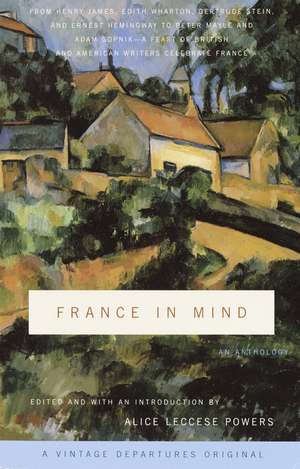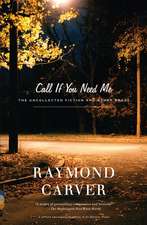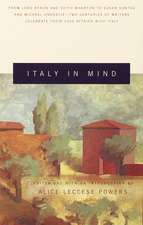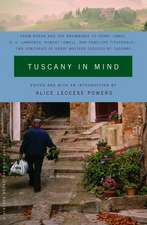France in Mind: Vintage Departures
Alice Leccese Powersen Limba Engleză Paperback – 28 feb 2003
The food and the people, the culture and viniculture, the architecture and the expatriates, the pleasures (and frustrations) of France are described by intrepid travelers who also happen to be brilliant essayists, poets, and novelists. From Gertrude Stein’s Paris to Ezra Pound’s Pyrenees; from Tobias Smollett, who grumbled, to Peter Mayle, who settled in; and from Edith Wharton on falling in love to David Sedaris on falling over French grammar–here is France in all its splendor in the words of some of the best and most entertaining writers in the English language.
Henry Adams • James Baldwin • Elizabeth Bishop • Mary Blume • James Fenimore Cooper • Charles Dickens • Lawrence Durrell • Lawrence Ferlinghetti • M. F. K. Fisher • F. Scott Fitzgerald • Janet Flanner • Adam Gopnik • Joanne Harris • Ernest Hemingway • Washington Irving • Henry James • Thomas Jefferson • Stanley Karnow • Peter Mayle • Mary McCarthy • Jan Morris • Ezra Pound • David Sedaris • Tobias Smollett • Gertrude Stein • Robert Louis Stevenson • Paul Theroux • Gillian Tindall • Calvin Trillin • Mark Twain • Edith Wharton • Richard Wilbur • William Carlos Williams
Din seria Vintage Departures
-
 Preț: 108.09 lei
Preț: 108.09 lei -
 Preț: 108.91 lei
Preț: 108.91 lei -
 Preț: 109.73 lei
Preț: 109.73 lei -
 Preț: 90.64 lei
Preț: 90.64 lei -
 Preț: 103.53 lei
Preț: 103.53 lei -
 Preț: 99.60 lei
Preț: 99.60 lei -
 Preț: 109.95 lei
Preț: 109.95 lei -
 Preț: 107.46 lei
Preț: 107.46 lei -
 Preț: 104.58 lei
Preț: 104.58 lei -
 Preț: 121.63 lei
Preț: 121.63 lei -
 Preț: 95.10 lei
Preț: 95.10 lei -
 Preț: 117.69 lei
Preț: 117.69 lei -
 Preț: 107.05 lei
Preț: 107.05 lei -
 Preț: 138.12 lei
Preț: 138.12 lei -
 Preț: 91.27 lei
Preț: 91.27 lei -
 Preț: 108.50 lei
Preț: 108.50 lei -
 Preț: 128.33 lei
Preț: 128.33 lei -
 Preț: 104.58 lei
Preț: 104.58 lei -
 Preț: 109.54 lei
Preț: 109.54 lei -
 Preț: 108.50 lei
Preț: 108.50 lei -
 Preț: 107.46 lei
Preț: 107.46 lei -
 Preț: 94.10 lei
Preț: 94.10 lei -
 Preț: 109.95 lei
Preț: 109.95 lei -
 Preț: 75.68 lei
Preț: 75.68 lei -
 Preț: 100.23 lei
Preț: 100.23 lei -
 Preț: 105.54 lei
Preț: 105.54 lei -
 Preț: 106.76 lei
Preț: 106.76 lei -
 Preț: 91.13 lei
Preț: 91.13 lei -
 Preț: 119.23 lei
Preț: 119.23 lei -
 Preț: 90.72 lei
Preț: 90.72 lei -
 Preț: 111.71 lei
Preț: 111.71 lei -
 Preț: 92.01 lei
Preț: 92.01 lei -
 Preț: 105.29 lei
Preț: 105.29 lei -
 Preț: 132.88 lei
Preț: 132.88 lei -
 Preț: 88.68 lei
Preț: 88.68 lei -
 Preț: 118.51 lei
Preț: 118.51 lei -
 Preț: 114.79 lei
Preț: 114.79 lei -
 Preț: 118.51 lei
Preț: 118.51 lei -
 Preț: 110.28 lei
Preț: 110.28 lei -
 Preț: 114.79 lei
Preț: 114.79 lei -
 Preț: 99.82 lei
Preț: 99.82 lei -
 Preț: 104.56 lei
Preț: 104.56 lei -
 Preț: 99.41 lei
Preț: 99.41 lei -
 Preț: 105.29 lei
Preț: 105.29 lei -
 Preț: 121.28 lei
Preț: 121.28 lei -
 Preț: 88.66 lei
Preț: 88.66 lei -
 Preț: 125.54 lei
Preț: 125.54 lei -
 Preț: 114.38 lei
Preț: 114.38 lei -
 Preț: 101.17 lei
Preț: 101.17 lei
Preț: 136.59 lei
Nou
Puncte Express: 205
Preț estimativ în valută:
26.14€ • 28.22$ • 21.92£
26.14€ • 28.22$ • 21.92£
Carte disponibilă
Livrare economică 28 martie-11 aprilie
Preluare comenzi: 021 569.72.76
Specificații
ISBN-13: 9780375714351
ISBN-10: 0375714359
Pagini: 320
Dimensiuni: 132 x 207 x 18 mm
Greutate: 0.22 kg
Editura: Vintage Publishing
Seria Vintage Departures
ISBN-10: 0375714359
Pagini: 320
Dimensiuni: 132 x 207 x 18 mm
Greutate: 0.22 kg
Editura: Vintage Publishing
Seria Vintage Departures
Notă biografică
Alice Leccese Powers is the editor of the anthologies Italy in Mind and Ireland in Mind, and co-editor of The Brooklyn Reader: Thirty Writers Celebrate America’s Favorite Borough. A freelance writer and editor, she has been published in The Washington Post, The Baltimore Sun, Newsday, and many other newspapers and magazines. Ms. Powers also teaches writing at the Corcoran School of Art and Georgetown University. She lives in Washington, D.C., with her husband and three daughters.
Extras
Henry Adams
(1838-1918)
The great-grandson of President John Adams and the grandson of President John Quincy Adams, Henry Adams was born into American political aristocracy. Like many of his class, the Harvard graduate embarked on the European Grand Tour in 1858--and stayed on the Continent for ten years, writing travel and scholarly articles about his experiences. Eventually, Adams returned to Washington, D.C., and set up a salon in a mansion near the White House. He and his wife, Marian (nicknamed Clover), were the most sought-after invitation in the post-Civil War capital. Their inner circle, called The Five of Hearts, included John and Clara Hay and Clarence King. Adams was shattered by Clover's suicide in 1885, and he resumed his restless traveling--through the Far East, the Caribbean, Mexico, Australia and Europe.
In 1895 Henry Adams made his first systematic study of the architecture of Mont St. Michel and Chartres. The result, Mont St. Michel and Chartres, was published privately in 1904 and again (in a slightly revised form) in 1912. Chartres came out as a trade edition published by the American Institute of Architects in 1913--and broke sales records. A stroke in 1913 ended Adams's travels, but he resumed the political salon in his Washington home. He died in 1918, shortly before the publication of his autobiography The Education of Henry Adams, for which he posthumously received the Pulitzer Prize. Henry Adams is buried in Washington next to his beloved Clover.
Towers and Portals
from Mont St. Michel and Chartres
For a first visit to Chartres, choose some pleasant morning when the lights are soft, for one wants to be welcome, and the Cathedral has moods, at times severe. At best, the Beauce is a country none too gay.
The first glimpse that is caught, and the first that was meant to be caught, is that of the two spires. With all the education that Normandy and the Isle de France can give, one is still ignorant. The spire is the simplest part of the Romanesque or Gothic architecture, and needs least study in order to be felt. It is a bit of sentiment almost pure of practical purpose. It tells the whole of its story at a glance, and its story is the best that architecture had to tell, for it typified the aspirations of man at the moment when man's aspirations were highest. Yet nine persons out of ten,--perhaps ninety-nine in a hundred,--who come within sight of the two spires of Chartres will think it a jest if they are told that the smaller of the two, the simpler, the one that impresses them least, is the one which they are expected to recognise as the most perfect piece of architecture in the world. Perhaps the French critics might deny that they make any such absolute claim; in that case you can ask them what their exact claim is; it will always be high enough to astonish the tourist.
Astonished or not, we have got to take this southern spire of the Chartres Cathedral as the object of serious study, and before taking it as art, must take it as history. The foundations of this tower--always to be known as the old tower,--are supposed to have been laid in 1091, before the first crusade. The flèche was probably half a century later (1145-1170). The foundations of the new tower, opposite, were laid not before 1110, when also the Portal, which stands between them, was begun with the three lancet windows above it, but not the Rose. For convenience, this old façade, including the Portal and the two towers, but not the flèches, and the three lancet windows, but not the Rose, may be dated as complete about 1150.
Originally the whole Portal,--the three doors and the three lancets--stood nearly forty feet back, on the line of the interior foundation, or rear wall of the towers. This arrangement threw the towers forward, free on three sides, as at Poitiers, and gave room for a Parvis, before the Portal,--a Porch, roofed over, to protect the pilgrims who always stopped there to pray before entering the church. When the church was rebuilt after the great fire of 1194, and the architect was required to enlarge the interior, the old Portal and lancets were moved bodily forward, to be flush with the front walls of the two towers, as you see the façade today; and the façade itself was heightened, to give room for the Rose, and to cover the loftier pignon and vaulting behind. Finally, the wooden roof, above the stone vault, was masked by the Arcade of Kings and its railing, completed in the taste of Philip the Hardy, who reigned from 1270 to 1285.
These changes have of course altered the values of all the parts. The Portal is injured by being thrown into a glare of light, when it was intended to stand in shadow, as you will see in the north and south Porches over the transept-portals. The towers are hurt by losing relief and shadow; but the old flèche is obliged to suffer the cruelest wrong of all by having its right shoulder hunched up by half of a huge Rose and the whole of a row of kings, when it was built to stand free, and to soar above the whole façade from the top of its second storey. One can easily figure it so, and replace the lost parts of the old façade, more or less at haphazard, from the front of Noyon.
What an outrage it was, you can see by a single glance at the new flèche opposite. The architect of 1500 has flatly refused to submit to such conditions, and has insisted, with very proper self-respect, on starting from the balustrade of the arcade of kings, as his level. Not even content with that, he has carried up his square tower another lofty storey before he would consent to touch the heart of his problem, the conversion of the square tower into the octagon flèche. In doing this, he has sacrificed once more the old flèche; but his own tower stands free as it should.
At Vendome, when you go there, you will be in a way to appreciate still better what happened to the Chartres flèche; for the clocher at Vendome, which is of the same date,--Viollet-le-Duc says earlier, and Enlart, "after 1130,"--stood, and still stands, free, like an Italian campanile, which gives it a vast advantage. The tower of St. Leu d'Esserent, also after 1130, stands free, above the second storey. Indeed, you will hardly find, in the long list of famous French spires, another which has been treated with so much indignity as this, the greatest and most famous of all; and perhaps the most annoying part of it is that you must be grateful to the architect of 1195 for doing no worse. He has on the contrary, done his best to show respect for the work of his predecessor, and has done so well that, handicapped as it is, the old tower still defies rivalry. Nearly three hundred and fifty feet high, or, to be exact, 106.50 metres from the church floor, it is built up with an amount of intelligence and refinement that leaves to unprofessional visitors no chance to think a criticism,--much less to express one. Perhaps--when we have seen more--and feel less--who knows? but certainly not now!
"The greatest, and surely the most beautiful monument of this kind that we possess in France," says Viollet-le-Duc; but although an ignorant spectator must accept the architect's decision on a point of relative merit, no one is compelled to accept his reasons as final. "There is no need to dwell," he continues, "upon the beauty and the grandeur of composition in which the artist has given proof of rare sobriety where all the effects are obtained not by ornaments but by the just and skilful proportion of the different parts. The transition, so hard to adjust, between the square base and the octagon of the flèche, is managed and carried out with an address which has not been surpassed in similar monuments."
One stumbles a little at the word "adresse." One never caught oneself using the word in Norman churches. Your photographs of Bayeux or Boscherville or Secqueville will show you at a glance whether the term "adresse" applies to them. Even Vendome would rather be praised for "droiture" than for "adresse." Whether the word address means cleverness, dexterity, adroitness, or simple technical skill, the thing itself is something which the French have always admired more than the Normans ever did. Viollet-le-Duc himself seems to be a little uncertain whether to lay most stress on the one or the other quality:--
"If one tries to appreciate the conception of this tower," quotes the Abbé Bulteau (II, 84.), "one will see that it is as frank as the execution is simple and skilful. Starting from the bottom, one reaches the summit of the flèche without marked break; without anything to interrupt the general form of the building. This clocher, whose base is broad (pleine), massive and free from ornament, transforms itself, as it springs, into a sharp spire with eight faces, without its being possible to say where the massive construction ends and the light construction begins."
Granting, as one must, that this concealment of the transition is a beauty, one would still like to be quite sure that the Chartres scheme is the best. The Norman clochers being thrown out, and that at Vendome being admittedly simple, the clocher de Saint Jean on the church of Saint Germain at Auxerre seems to be thought among the next in importance, although it is only about one hundred and sixty feet in height (49 metres), and therefore hardly in the same class with Chartres. Any photograph shows that the Auxerre spire is also simple; and that at Etampes you have seen already to be of the Vendome rather than of the Chartres type. The clocher at Senlis is more "habile"; it shows an effort to be clever, and offers a standard of comparison; but the mediæval architects seem to have thought that none of them bore rivalry with Laon for technical skill. One of these professional experts, named Villard de Honnecourt, who lived between 1200 and 1250, left a note-book which you can see in the vitrines of the Bibliothèque Nationale in the Rue Richelieu, and which is the source of most that is known about the practical ideas of mediæval architects. He came to Chartres, and, standing here before the doors, where we are standing, he made a rough drawing, not of the tower but of the Rose, which was then probably new, since it must have been planned between 1195 and 1200. Apparently the tower did not impress him strongly, for he made no note of it; but on the other hand, when he went to Laon, he became vehement in praise of the cathedral tower there, which must have been then quite new: "I have been in many countries, as you can find in this book. In no place have I ever such a tower seen as that of Laon.--J'ai esté en mult de tieres, si cum vus porés trover en cest livre. En aucun liu onques tel tor ne vi com est cele de Loon." The reason for this admiration is the same that Viollet-le-Duc gives for admiring the tower of Chartres,--the "adresse" with which the square is changed into the octagon. Not only is the tower itself changed into the flèche without visible junction, under cover of four corner tourelles, of open work, on slender columns, which start as squares; but the tourelles also convert themselves into octagons in the very act of rising, and end in octagon flèches that carry up--or once carried up--the lines of profile to the central flèches that soared above them. Clearly this device far surpassed in cleverness the scheme of Chartres, which was comparatively heavy and structural, the weights being adjusted for their intended work, while the transformation at Laon takes place in the air, and challenges discovery in defiance of one's keenest eyesight. "Regard . . . how the tourelles pass from one disposition to another, in rising! Meditate on it!"
The flèche of Laon is gone, but the tower and tourelles are still there to show what the architects of the thirteenth century thought their most brilliant achievement. One cannot compare Chartres directly with any of its contemporary rivals, but one can at least compare the old spire with the new one which stands opposite and rises above it. Perhaps you will like the new best. Built at a time which is commonly agreed to have had the highest standard of taste, it does not encourage tourist or artist to insist on setting up standards of their own against it. Begun in 1507, it was finished in 1517. The dome of St. Peter's at Rome, over which Bramante and Rafael and Michael Angelo toiled, was building at the same time; Leonardo da Vinci was working at Amboise; Jean Bullant, Pierre Lescot, and their patron Francis the First, were beginning their architectural careers. Four hundred years, or thereabouts, separated the old spire from the new one; and four hundred more separate the new one from us. If Viollet-le-Duc, who himself built Gothic spires, had cared to compare his flèches at Clermont-Ferrand with the new flèche at Chartres, he might perhaps have given us a rule where "adresse" ceases to have charm, and where detail becomes tiresome; but in the want of a schoolmaster to lay down a law of taste, you can admire the new flèche as much as you please. Of course one sees that the lines of the new tower are not clean, like those of the old; the devices that cover the transition from the square to the octagon are rather too obvious; the proportion of the flèche to the tower quite alters the values of the parts; a rigid classical taste might even go so far as to hint that the new tower, in comparison with the old, showed signs of a certain tendency towards a dim and distant vulgarity. There can be no harm in admitting that the new tower is a little wanting in repose for a tower whose business is to counterpoise the very classic lines of the old one; but no law compels you to insist on absolute repose in any form of art; if such a law existed, it would have to deal with Michael Angelo before it dealt with us. The new tower has many faults, but it has great beauties, as you can prove by comparing it with other late Gothic spires including those of Viollet-le-Duc. Its chief fault is to be where it is. As a companion to the crusades and to Saint Bernard, it lacks austerity. As a companion to the Virgin of Chartres, it recalls Diane de Poitiers.
(1838-1918)
The great-grandson of President John Adams and the grandson of President John Quincy Adams, Henry Adams was born into American political aristocracy. Like many of his class, the Harvard graduate embarked on the European Grand Tour in 1858--and stayed on the Continent for ten years, writing travel and scholarly articles about his experiences. Eventually, Adams returned to Washington, D.C., and set up a salon in a mansion near the White House. He and his wife, Marian (nicknamed Clover), were the most sought-after invitation in the post-Civil War capital. Their inner circle, called The Five of Hearts, included John and Clara Hay and Clarence King. Adams was shattered by Clover's suicide in 1885, and he resumed his restless traveling--through the Far East, the Caribbean, Mexico, Australia and Europe.
In 1895 Henry Adams made his first systematic study of the architecture of Mont St. Michel and Chartres. The result, Mont St. Michel and Chartres, was published privately in 1904 and again (in a slightly revised form) in 1912. Chartres came out as a trade edition published by the American Institute of Architects in 1913--and broke sales records. A stroke in 1913 ended Adams's travels, but he resumed the political salon in his Washington home. He died in 1918, shortly before the publication of his autobiography The Education of Henry Adams, for which he posthumously received the Pulitzer Prize. Henry Adams is buried in Washington next to his beloved Clover.
Towers and Portals
from Mont St. Michel and Chartres
For a first visit to Chartres, choose some pleasant morning when the lights are soft, for one wants to be welcome, and the Cathedral has moods, at times severe. At best, the Beauce is a country none too gay.
The first glimpse that is caught, and the first that was meant to be caught, is that of the two spires. With all the education that Normandy and the Isle de France can give, one is still ignorant. The spire is the simplest part of the Romanesque or Gothic architecture, and needs least study in order to be felt. It is a bit of sentiment almost pure of practical purpose. It tells the whole of its story at a glance, and its story is the best that architecture had to tell, for it typified the aspirations of man at the moment when man's aspirations were highest. Yet nine persons out of ten,--perhaps ninety-nine in a hundred,--who come within sight of the two spires of Chartres will think it a jest if they are told that the smaller of the two, the simpler, the one that impresses them least, is the one which they are expected to recognise as the most perfect piece of architecture in the world. Perhaps the French critics might deny that they make any such absolute claim; in that case you can ask them what their exact claim is; it will always be high enough to astonish the tourist.
Astonished or not, we have got to take this southern spire of the Chartres Cathedral as the object of serious study, and before taking it as art, must take it as history. The foundations of this tower--always to be known as the old tower,--are supposed to have been laid in 1091, before the first crusade. The flèche was probably half a century later (1145-1170). The foundations of the new tower, opposite, were laid not before 1110, when also the Portal, which stands between them, was begun with the three lancet windows above it, but not the Rose. For convenience, this old façade, including the Portal and the two towers, but not the flèches, and the three lancet windows, but not the Rose, may be dated as complete about 1150.
Originally the whole Portal,--the three doors and the three lancets--stood nearly forty feet back, on the line of the interior foundation, or rear wall of the towers. This arrangement threw the towers forward, free on three sides, as at Poitiers, and gave room for a Parvis, before the Portal,--a Porch, roofed over, to protect the pilgrims who always stopped there to pray before entering the church. When the church was rebuilt after the great fire of 1194, and the architect was required to enlarge the interior, the old Portal and lancets were moved bodily forward, to be flush with the front walls of the two towers, as you see the façade today; and the façade itself was heightened, to give room for the Rose, and to cover the loftier pignon and vaulting behind. Finally, the wooden roof, above the stone vault, was masked by the Arcade of Kings and its railing, completed in the taste of Philip the Hardy, who reigned from 1270 to 1285.
These changes have of course altered the values of all the parts. The Portal is injured by being thrown into a glare of light, when it was intended to stand in shadow, as you will see in the north and south Porches over the transept-portals. The towers are hurt by losing relief and shadow; but the old flèche is obliged to suffer the cruelest wrong of all by having its right shoulder hunched up by half of a huge Rose and the whole of a row of kings, when it was built to stand free, and to soar above the whole façade from the top of its second storey. One can easily figure it so, and replace the lost parts of the old façade, more or less at haphazard, from the front of Noyon.
What an outrage it was, you can see by a single glance at the new flèche opposite. The architect of 1500 has flatly refused to submit to such conditions, and has insisted, with very proper self-respect, on starting from the balustrade of the arcade of kings, as his level. Not even content with that, he has carried up his square tower another lofty storey before he would consent to touch the heart of his problem, the conversion of the square tower into the octagon flèche. In doing this, he has sacrificed once more the old flèche; but his own tower stands free as it should.
At Vendome, when you go there, you will be in a way to appreciate still better what happened to the Chartres flèche; for the clocher at Vendome, which is of the same date,--Viollet-le-Duc says earlier, and Enlart, "after 1130,"--stood, and still stands, free, like an Italian campanile, which gives it a vast advantage. The tower of St. Leu d'Esserent, also after 1130, stands free, above the second storey. Indeed, you will hardly find, in the long list of famous French spires, another which has been treated with so much indignity as this, the greatest and most famous of all; and perhaps the most annoying part of it is that you must be grateful to the architect of 1195 for doing no worse. He has on the contrary, done his best to show respect for the work of his predecessor, and has done so well that, handicapped as it is, the old tower still defies rivalry. Nearly three hundred and fifty feet high, or, to be exact, 106.50 metres from the church floor, it is built up with an amount of intelligence and refinement that leaves to unprofessional visitors no chance to think a criticism,--much less to express one. Perhaps--when we have seen more--and feel less--who knows? but certainly not now!
"The greatest, and surely the most beautiful monument of this kind that we possess in France," says Viollet-le-Duc; but although an ignorant spectator must accept the architect's decision on a point of relative merit, no one is compelled to accept his reasons as final. "There is no need to dwell," he continues, "upon the beauty and the grandeur of composition in which the artist has given proof of rare sobriety where all the effects are obtained not by ornaments but by the just and skilful proportion of the different parts. The transition, so hard to adjust, between the square base and the octagon of the flèche, is managed and carried out with an address which has not been surpassed in similar monuments."
One stumbles a little at the word "adresse." One never caught oneself using the word in Norman churches. Your photographs of Bayeux or Boscherville or Secqueville will show you at a glance whether the term "adresse" applies to them. Even Vendome would rather be praised for "droiture" than for "adresse." Whether the word address means cleverness, dexterity, adroitness, or simple technical skill, the thing itself is something which the French have always admired more than the Normans ever did. Viollet-le-Duc himself seems to be a little uncertain whether to lay most stress on the one or the other quality:--
"If one tries to appreciate the conception of this tower," quotes the Abbé Bulteau (II, 84.), "one will see that it is as frank as the execution is simple and skilful. Starting from the bottom, one reaches the summit of the flèche without marked break; without anything to interrupt the general form of the building. This clocher, whose base is broad (pleine), massive and free from ornament, transforms itself, as it springs, into a sharp spire with eight faces, without its being possible to say where the massive construction ends and the light construction begins."
Granting, as one must, that this concealment of the transition is a beauty, one would still like to be quite sure that the Chartres scheme is the best. The Norman clochers being thrown out, and that at Vendome being admittedly simple, the clocher de Saint Jean on the church of Saint Germain at Auxerre seems to be thought among the next in importance, although it is only about one hundred and sixty feet in height (49 metres), and therefore hardly in the same class with Chartres. Any photograph shows that the Auxerre spire is also simple; and that at Etampes you have seen already to be of the Vendome rather than of the Chartres type. The clocher at Senlis is more "habile"; it shows an effort to be clever, and offers a standard of comparison; but the mediæval architects seem to have thought that none of them bore rivalry with Laon for technical skill. One of these professional experts, named Villard de Honnecourt, who lived between 1200 and 1250, left a note-book which you can see in the vitrines of the Bibliothèque Nationale in the Rue Richelieu, and which is the source of most that is known about the practical ideas of mediæval architects. He came to Chartres, and, standing here before the doors, where we are standing, he made a rough drawing, not of the tower but of the Rose, which was then probably new, since it must have been planned between 1195 and 1200. Apparently the tower did not impress him strongly, for he made no note of it; but on the other hand, when he went to Laon, he became vehement in praise of the cathedral tower there, which must have been then quite new: "I have been in many countries, as you can find in this book. In no place have I ever such a tower seen as that of Laon.--J'ai esté en mult de tieres, si cum vus porés trover en cest livre. En aucun liu onques tel tor ne vi com est cele de Loon." The reason for this admiration is the same that Viollet-le-Duc gives for admiring the tower of Chartres,--the "adresse" with which the square is changed into the octagon. Not only is the tower itself changed into the flèche without visible junction, under cover of four corner tourelles, of open work, on slender columns, which start as squares; but the tourelles also convert themselves into octagons in the very act of rising, and end in octagon flèches that carry up--or once carried up--the lines of profile to the central flèches that soared above them. Clearly this device far surpassed in cleverness the scheme of Chartres, which was comparatively heavy and structural, the weights being adjusted for their intended work, while the transformation at Laon takes place in the air, and challenges discovery in defiance of one's keenest eyesight. "Regard . . . how the tourelles pass from one disposition to another, in rising! Meditate on it!"
The flèche of Laon is gone, but the tower and tourelles are still there to show what the architects of the thirteenth century thought their most brilliant achievement. One cannot compare Chartres directly with any of its contemporary rivals, but one can at least compare the old spire with the new one which stands opposite and rises above it. Perhaps you will like the new best. Built at a time which is commonly agreed to have had the highest standard of taste, it does not encourage tourist or artist to insist on setting up standards of their own against it. Begun in 1507, it was finished in 1517. The dome of St. Peter's at Rome, over which Bramante and Rafael and Michael Angelo toiled, was building at the same time; Leonardo da Vinci was working at Amboise; Jean Bullant, Pierre Lescot, and their patron Francis the First, were beginning their architectural careers. Four hundred years, or thereabouts, separated the old spire from the new one; and four hundred more separate the new one from us. If Viollet-le-Duc, who himself built Gothic spires, had cared to compare his flèches at Clermont-Ferrand with the new flèche at Chartres, he might perhaps have given us a rule where "adresse" ceases to have charm, and where detail becomes tiresome; but in the want of a schoolmaster to lay down a law of taste, you can admire the new flèche as much as you please. Of course one sees that the lines of the new tower are not clean, like those of the old; the devices that cover the transition from the square to the octagon are rather too obvious; the proportion of the flèche to the tower quite alters the values of the parts; a rigid classical taste might even go so far as to hint that the new tower, in comparison with the old, showed signs of a certain tendency towards a dim and distant vulgarity. There can be no harm in admitting that the new tower is a little wanting in repose for a tower whose business is to counterpoise the very classic lines of the old one; but no law compels you to insist on absolute repose in any form of art; if such a law existed, it would have to deal with Michael Angelo before it dealt with us. The new tower has many faults, but it has great beauties, as you can prove by comparing it with other late Gothic spires including those of Viollet-le-Duc. Its chief fault is to be where it is. As a companion to the crusades and to Saint Bernard, it lacks austerity. As a companion to the Virgin of Chartres, it recalls Diane de Poitiers.
Descriere
From Gertrude Stein's Paris to Ezra Pound's Pyrenees; from Tobias Smollett, who grumbled, to Peter Mayle, who settled in; and from Mark Twain's "Innocents Abroad" to David Sedaris's "Me Talk Pretty One Day"--here is France in all its splendor in the words of some of the best and most entertaining writers in the English language.

















